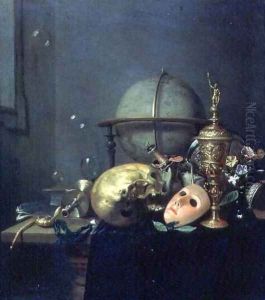Hendrick Andriessen Paintings
Hendrick Andriessen, also known as Mancken Heyn or Hendrick Andriessen van den Bempden, was a Dutch Golden Age still-life painter born in Antwerp in 1607. He was part of a family of artists; his father was a painter and his brothers also took up the arts. Andriessen is primarily known for his 'vanitas' paintings, a style that serves as a reminder of the transience of life, the futility of pleasure, and the certainty of death, often contrasting symbols of wealth and power with symbols of mortality and decay.
Andriessen's work typically featured traditional vanitas elements such as skulls, hourglasses, extinguished candles, books, musical instruments, and other objects symbolizing human achievements and pleasures. These items were not only meticulously rendered to show off the artist's skill but also thoughtfully composed to evoke reflection on life's impermanence. The dark, moody settings of his paintings underscored the somber themes he explored.
Little is known about Andriessen's life and training. However, his work suggests that he was keenly aware of the intellectual currents of his time and that he was likely influenced by other Dutch and Flemish artists who specialized in the genre of still life. His paintings possess a quiet intensity and are noted for their fine detail and subtle interplay of light and shadow.
Hendrick Andriessen's paintings were collected by patrons who appreciated the moral and aesthetic dimensions of his work. Despite the popularity of vanitas paintings during his lifetime, Andriessen did not achieve the lasting fame of some of his contemporaries. His death in 1655 in Antwerp marked the end of a career that, while it may not have been illustrious by the standards of art history, contributed significantly to the vanitas tradition within the Dutch Golden Age of painting. Today, his work is studied and appreciated for its craftsmanship and philosophical depth, serving as an important example of the vanitas genre.



